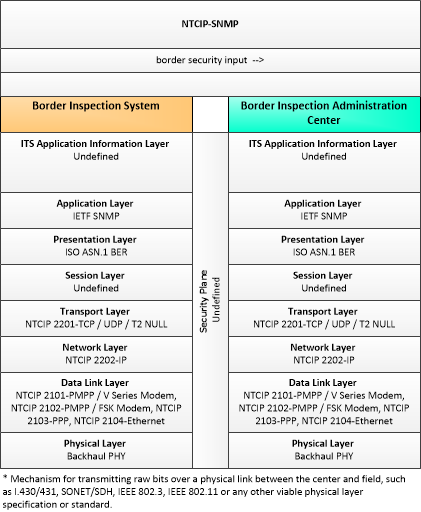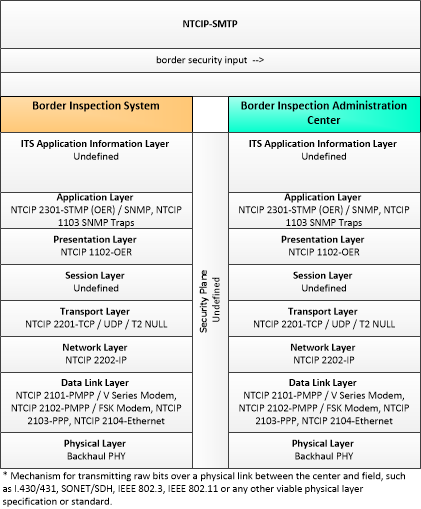Link Type: Center to Field
Border Inspection System --> Border Inspection Administration Center:
border security input
Definitions
border security input (Information Flow): Information regarding security related events occurring at the border.
Border Inspection System (Source Physical Object): 'Border Inspection System' represents data systems used at the border for the inspection of people or goods. It supports immigration, customs (trade), agricultural, and FDA inspections as applicable. It includes sensors and surveillance systems to identify and classify drivers and their cargo as they approach a border crossing, the systems used to interface with the back-office administration systems and provide information on status of the crossing or events.
Border Inspection Administration Center (Destination Physical Object): 'Border Inspection Administration Center' represents back-office systems and databases run by domestic and foreign governmental agencies responsible for the regulation of trade, and the enforcement of customs and immigration laws. These agencies include U.S. Department of Homeland Security (DHS) and its counterparts in Canada and Mexico. DHS includes components like Customs and Border Protection (CBP), Immigration and Customs Enforcement (ICE), and Transportation Security Administration (TSA). Other agencies include secondary trade agencies (e.g., U.S. Food and Drug Administration, U.S. Department of Agriculture, other USDOT departments, etc.), and agencies from other trading nations. The systems they manage coordinate activities related to the border crossings. These systems support import/export cargo processing and enforcement operations at the border, including programs such as FAST, Automated Commercial Environment (ACE), Nexus (Canada), SENTRI (Mexico), and US-VISIT.
Included In
This Information Flow is in the following Applications:
This Information Flow is in the following Application Objects:
Communication Diagrams
The communication diagram(s) can be viewed in SVG or PNG format and the current format is SVG. Switch to PNG format.
This profile describes an alternative set of standards used to communicate with ITS Roadway Devices that uses the NTCIP Octet Encoding Rules (OER), a standard developed specifically for the transportation industry. This template is used primarily for communication with traffic signal controllers, where second-per-second communications is required. This template also includes standards for SNMP traps, that allows an ITS Roadway Device to initiate event-driven communications with a receiver.
Characteristics
Architectural:
| Characteristic | Value |
|---|---|
| Time Context | Recent |
| Spatial Context | Local |
| Acknowledgement | True |
| Cardinality | Unicast |
| Initiator | Source |
Security
This information flow triple is in the following applications with the following security levels.
| Information Flow Security | |||||
|---|---|---|---|---|---|
| Application | Confidentiality | Integrity | Availability | ||
| Basis | Basis | Basis | |||
| Border Management Systems | Moderate | Moderate | Low | ||
| Since this is describing events that already occurred it is possible that someone could observe these by sitting at the border and watching. However some things in this may be slightly sensitive in nature and should not be completely visible to anyone. If this flow could carry instructions to be acted on at a later point (e.g. "Suspicious traveler, pull over down the road and investigate"), this could potentially be HIGH because it is potentially national security related information; however, it is not clear from the CVRIA description whether or not this will be the case. | This information could affect how the BIAC responds to a request on a person in the future. As such this information should be relatively secure; however mistakes in the information do not have a major impact on anything. | This information requires an acknowledgment of receipt, but if a message is missed it could be sent again at a later time without any impact on the rest of the system. | |||

